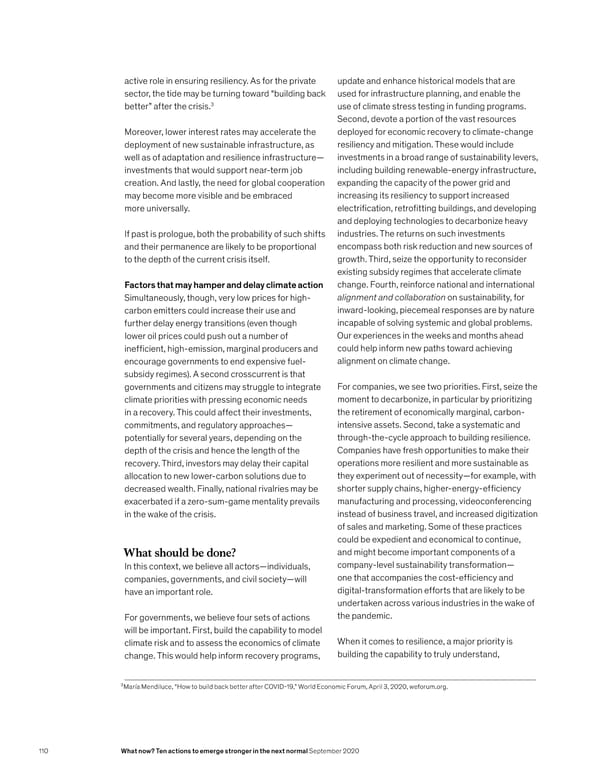active role in ensuring resiliency. As for the private update and enhance historical models that are sector, the tide may be turning toward “building back used for infrastructure planning, and enable the better” after the crisis.3 use of climate stress testing in funding programs. Second, devote a portion of the vast resources Moreover, lower interest rates may accelerate the deployed for economic recovery to climate-change deployment of new sustainable infrastructure, as resiliency and mitigation. These would include well as of adaptation and resilience infrastructure— investments in a broad range of sustainability levers, investments that would support near-term job including building renewable-energy infrastructure, creation. And lastly, the need for global cooperation expanding the capacity of the power grid and may become more visible and be embraced increasing its resiliency to support increased more universally. electrification, retrofitting buildings, and developing and deploying technologies to decarbonize heavy If past is prologue, both the probability of such shifts industries. The returns on such investments and their permanence are likely to be proportional encompass both risk reduction and new sources of to the depth of the current crisis itself. growth. Third, seize the opportunity to reconsider existing subsidy regimes that accelerate climate Factors that may hamper and delay climate action change. Fourth, reinforce national and international Simultaneously, though, very low prices for high- alignment and collaboration on sustainability, for carbon emitters could increase their use and inward-looking, piecemeal responses are by nature further delay energy transitions (even though incapable of solving systemic and global problems. lower oil prices could push out a number of Our experiences in the weeks and months ahead inefficient, high-emission, marginal producers and could help inform new paths toward achieving encourage governments to end expensive fuel- alignment on climate change. subsidy regimes). A second crosscurrent is that governments and citizens may struggle to integrate For companies, we see two priorities. First, seize the climate priorities with pressing economic needs moment to decarbonize, in particular by prioritizing in a recovery. This could affect their investments, the retirement of economically marginal, carbon- commitments, and regulatory approaches— intensive assets. Second, take a systematic and potentially for several years, depending on the through-the-cycle approach to building resilience. depth of the crisis and hence the length of the Companies have fresh opportunities to make their recovery. Third, investors may delay their capital operations more resilient and more sustainable as allocation to new lower-carbon solutions due to they experiment out of necessity—for example, with decreased wealth. Finally, national rivalries may be shorter supply chains, higher-energy-efficiency exacerbated if a zero-sum-game mentality prevails manufacturing and processing, videoconferencing in the wake of the crisis. instead of business travel, and increased digitization of sales and marketing. Some of these practices could be expedient and economical to continue, What should be done? and might become important components of a In this context, we believe all actors—individuals, company-level sustainability transformation— companies, governments, and civil society—will one that accompanies the cost-efficiency and have an important role. digital-transformation efforts that are likely to be undertaken across various industries in the wake of For governments, we believe four sets of actions the pandemic. will be important. First, build the capability to model climate risk and to assess the economics of climate When it comes to resilience, a major priority is change. This would help inform recovery programs, building the capability to truly understand, 3 María Mendiluce, “How to build back better after COVID-19,” World Economic Forum, April 3, 2020, weforum.org. 110 What now? Ten actions to emerge stronger in the next normal September 2020
 What Now? Page 111 Page 113
What Now? Page 111 Page 113